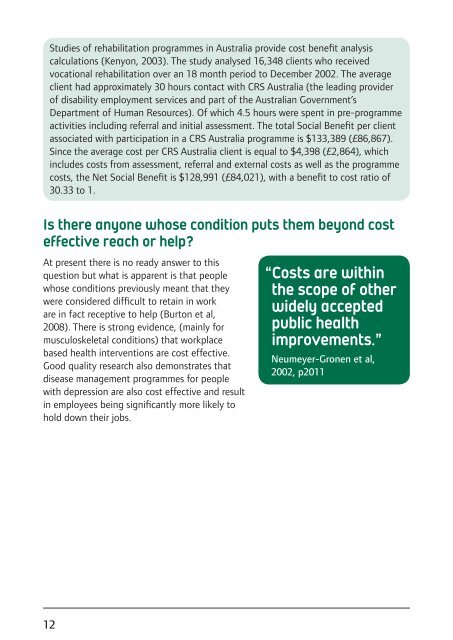Vocational rehabilitation The business case for retaining newly disabled staff and those with a long-term health condition
Vocational rehabilitation The business case for retaining newly disabled staff and those with a long-term health condition
Vocational rehabilitation The business case for retaining newly disabled staff and those with a long-term health condition
You also want an ePaper? Increase the reach of your titles
YUMPU automatically turns print PDFs into web optimized ePapers that Google loves.
Studies of <strong>rehabilitation</strong> programmes in Australia provide cost benefit analysis<br />
calculations (Kenyon, 2003). <strong>The</strong> study analysed 16,348 clients who received<br />
vocational <strong>rehabilitation</strong> over an 18 month period to December 2002. <strong>The</strong> average<br />
client had approximately 30 hours contact <strong>with</strong> CRS Australia (the leading provider<br />
of disability employment services <strong>and</strong> part of the Australian Government’s<br />
Department of Human Resources). Of which 4.5 hours were spent in pre-programme<br />
activities including referral <strong>and</strong> initial assessment. <strong>The</strong> total Social Benefit per client<br />
associated <strong>with</strong> participation in a CRS Australia programme is $133,389 (£86,867).<br />
Since the average cost per CRS Australia client is equal to $4,398 (£2,864), which<br />
includes costs from assessment, referral <strong>and</strong> external costs as well as the programme<br />
costs, the Net Social Benefit is $128,991 (£84,021), <strong>with</strong> a benefit to cost ratio of<br />
30.33 to 1.<br />
Is there anyone whose <strong>condition</strong> puts them beyond cost<br />
effective reach or help?<br />
At present there is no ready answer to this<br />
question but what is apparent is that people<br />
whose <strong>condition</strong>s previously meant that they<br />
were considered difficult to retain in work<br />
are in fact receptive to help (Burton et al,<br />
2008). <strong>The</strong>re is strong evidence, (mainly <strong>for</strong><br />
musculoskeletal <strong>condition</strong>s) that workplace<br />
based <strong>health</strong> interventions are cost effective.<br />
Good quality research also demonstrates that<br />
disease management programmes <strong>for</strong> people<br />
<strong>with</strong> depression are also cost effective <strong>and</strong> result<br />
in employees being significantly more likely to<br />
hold down their jobs.<br />
“Costs are <strong>with</strong>in<br />
the scope of other<br />
widely accepted<br />
public <strong>health</strong><br />
improvements.”<br />
Neumeyer-Gronen et al,<br />
2002, p2011<br />
12


